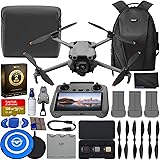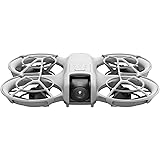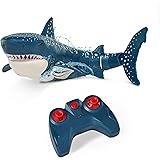The FPV drone landscape is constantly evolving, pushing the boundaries of performance and form factor. A notable development capturing enthusiasts’ attention is the emergence of the 4-inch hexacopter. Specifically, the Flywoo Hexplorer LR4 hexacopter arrives on the scene weighing 210 grams dry, a significant increase from its 165-gram quadcopter sibling. This substantial weight difference raises a fundamental question for many pilots: does the addition of two motors genuinely translate to a superior flying experience, or is it merely a novel configuration?
As explored in the accompanying video, the Flywoo Hexplorer LR4 hexacopter presents an intriguing proposition, marrying the popular micro long-range (LR) drone category with a multi-rotor design traditionally reserved for larger, heavier lift applications. This article delves deeper into the engineering innovations, practical implications, and real-world flight characteristics that define this unique FPV drone.
Engineering the Hexacopter: Frame & the Revolutionary 6-in-1 ESC
The foundation of any robust FPV drone lies in its frame. The original Flywoo Explorer LR4 quadcopter boasted a strong pedigree, drawing inspiration from the pioneering work of Dave C, a recognized figure in the micro long-range community. Flywoo meticulously adapted this proven design to create the hexacopter variant.
Frame Evolution and Durability
Upon initial inspection, the top plate of the hexacopter remains largely identical to its quadcopter predecessor. This design continuity suggests a focus on preserving the structural integrity and component mounting points that worked well. However, the true innovation lies in the redesigned bottom plate. This crucial element has been strategically extended to accommodate the two additional arms, each secured by a single screw and featuring a distinctive Y-shape at its base. This Y-design provides additional bracing, extending backward to a stack screw and forward to meet the front arm, enhancing overall rigidity. This thoughtful reinforcement is vital for managing the increased thrust and potential stresses from six motors.
The Breakthrough 6-in-1 ESC
Central to the Flywoo Hexplorer LR4 hexacopter’s existence is its groundbreaking 6-in-1 Electronic Speed Controller (ESC). For FPV builders, integrating six separate ESCs or finding a compact solution for a hexacopter on a small 4-inch frame has historically posed a significant challenge. The Flywoo 6-in-1 ESC, notably in a compact 20mm form factor, solves this problem directly. This single board streamlines the build process, reduces wiring complexity, and optimizes space utilization, making the hexacopter design feasible within a micro long-range footprint. Its existence is not just convenient; it is a critical enabling technology for this class of drone.
The Brains Behind the Flight: Upgraded Flight Controller Features
Beyond the frame and propulsion, the flight controller serves as the drone’s brain, dictating performance and functionality. The Flywoo Hexplorer LR4 hexacopter incorporates substantial upgrades here, significantly enhancing its capabilities and user experience.
F4 to F7 Processor: A Performance Leap
The hexacopter version features an F7 processor, a notable upgrade from the F4 processor found in the quadcopter. While the F7 processor inherently offers faster processing speeds, the more critical improvement lies in its expanded peripheral support. The F4 processor often necessitates using a “soft serial” port for certain functions, such as the DJI On-Screen Display (OSD). This can lead to annoying OSD dropouts and freezing during flight. In contrast, the F7 processor on the hexacopter provides five or six dedicated hardware UARTs. This abundance ensures that vital components like GPS, DJI OSD, and receiver can all operate on hardware UARTs, resulting in far greater stability and reliability for your onscreen information and flight data.
Integrated Barometer: Precision Altitude Control
A significant addition to the hexacopter’s flight controller is an onboard barometer, or pressure sensor. Many FPV pilots understand that GPS can be notoriously inaccurate when it comes to altitude measurements. This can be problematic, especially during critical maneuvers like GPS rescue. Without a barometer, GPS rescue might exhibit erratic altitude behavior, potentially wasting battery life or climbing to unsafe heights. The integrated barometer provides precise altitude information, greatly improving the accuracy and safety of autonomous functions like GPS return-to-home. Furthermore, the inclusion of a barometer means this flight controller supports an INAV target, simplifying the process for pilots who prefer the INAV firmware for advanced navigation and waypoint capabilities.
Addressing GPS Challenges
Reliable GPS acquisition has been a persistent issue for micro 4-inch builds. Pilots often experience slow satellite locks, insufficient satellite counts, or even signal loss mid-flight. One suspected culprit is electromagnetic interference from other onboard electronics, particularly the Caddx Vista video transmission system, operating at frequencies that can disrupt GPS signals. Flywoo has attempted to mitigate this by wrapping GPS wires in copper foil to limit electrical interference. While a commendable effort, tests indicate that this measure offers only minimal effectiveness unless a direct ground wire is soldered to the foil. This highlights an ongoing challenge within the micro long-range segment, prompting many pilots to seek additional optimization tips for improving GPS performance.
Enhanced User Experience: Bluetooth and Betaflight Optimization
Beyond raw performance, user convenience and fine-tuning capabilities are paramount for serious FPV pilots. The Flywoo Hexplorer LR4 hexacopter addresses these with intelligent design choices and optimized Betaflight settings.
Seamless Field Configuration with Bluetooth
A truly convenient feature is the onboard Bluetooth adapter. This eliminates the need for carrying a laptop or computer to the flying field for configuration adjustments. With a compatible smartphone app like SpeedyBee, pilots can connect wirelessly to their flight controller and access nearly all Betaflight settings. While command-line interface (CLI) inputs might be somewhat tedious on a touchscreen, the ability to perform comprehensive configurations directly from a smartphone is a significant advantage for quick tweaks and troubleshooting on the go. This level of accessibility enhances the overall user experience.
Optimized Betaflight Settings for the Flywoo Hexplorer LR4 Hexacopter
Flywoo pre-configures the Betaflight firmware on the hexacopter, but several adjustments can further optimize performance and safety:
- Battery Voltage Thresholds: For users employing high-voltage (HV) batteries, increasing the maximum cell voltage from the default 4.3V to 4.4V is recommended to fully utilize battery capacity. Conversely, for lithium-ion batteries, adjusting the warning cell voltage from 3.5V down to 3.1V or even 3.0V is advisable, as these batteries can safely discharge to 2.5V without damage. Standard LiPo batteries generally perform well with default settings.
- RSSI/LQ Configuration: The flight controller ships with AUX 8 pre-configured as the RSSI channel, which is ideal for Crossfire users. To enable 12-channel mode on Crossfire for dedicated LQ output, pilots can temporarily switch to 12-channel mode, assign LQ to AUX 8 (channel 12), then revert to 8-channel mode. This “trick” allows LQ data on channel 12 without incurring the performance penalty of full 12-channel operation.
- Throttle Stick Low Threshold: The default stick low threshold of 1050 acts as a safety measure but can reduce low-throttle precision. If your transmitter’s endpoints are correctly calibrated (ranging from 1000 to 2000), lowering this threshold to 1010 provides more granular control at the bottom end of the throttle stick, enhancing responsiveness during precise maneuvers.
- Custom OSD Layout: For pilots using digital video systems like DJI, customizing the OSD display is crucial. A tailored OSD can present vital information such as cell voltage, RSSI, and GPS data (waypoints, distance to home, altitude) that might not be visible by default. This ensures all critical flight parameters are readily available.
- GPS Rescue Failsafe: The hexacopter defaults to GPS rescue as its failsafe behavior, which is critical for long-range flights. However, the “allow arming without fix” option is enabled. This means the drone will arm even without the minimum of five GPS satellites locked. While this allows for freestyle flights without waiting for a lock, pilots must consciously verify at least five satellites before any long-range flight to ensure GPS rescue functionality. This places the responsibility of pre-flight checks firmly on the pilot.
Field Performance: Freestyle & Long-Range Capabilities
Ultimately, the true test of any FPV drone occurs in the air. The Flywoo Hexplorer LR4 hexacopter was subjected to flight tests to evaluate its capabilities across different flying styles, providing insights into its practical performance.
Carrying the Load: GoPro and Battery
During freestyle tests, the Flywoo Hexplorer LR4 hexacopter was equipped with an 850mAh 4S battery and a GoPro Hero 8 camera, bringing the total weight to approximately 550 grams. The added weight of the GoPro is a common consideration for pilots looking to capture high-quality footage. The drone achieved hover at around 45-50% throttle, indicating the extra motors provide ample lift for the additional payload.
Freestyle Performance: A “Chonker” with Potential
Flywoo’s marketing suggests the hexacopter has sufficient thrust for freestyle flying, not just cruising, even with a GoPro. In practice, the hexacopter felt like a “chonker” – robust but noticeably heavier than its quadcopter counterpart or dedicated freestyle machines like the Catalyst Machineworks Shocker. While capable of fast maneuvers, it didn’t possess the same loose, nimble feel. Battery sag was evident during full-throttle punches, and landings felt harder. A noticeable “bounce” persisted, suggesting the default tune isn’t optimized for aggressive freestyle. This implies that pilots seeking a truly nimble freestyle experience with the Flywoo Hexplorer LR4 hexacopter will likely need to engage in custom tuning.
Hexacopter vs. Quadcopter: A Direct Comparison
The core question remains: does the hexacopter configuration offer tangible benefits over the quadcopter, especially when considering the identical 850mAh 4S battery? When the quadcopter was flown with the same 850mAh 4S pack and no GoPro, relying solely on the DJI DVR for recording, a compelling case emerged. The quadcopter felt zippier, exhibited more pop and punch, and its throttle response was more aligned with preferred settings. The quality of DJI DVR footage is often sufficient for casual viewing, reducing the necessity for a heavy GoPro payload for every flight.
The hexacopter’s increased motor count provides redundancy—a significant safety advantage for long-range flights, where a single motor failure would not necessarily result in a complete loss of the aircraft. However, this comes at the cost of increased weight and reduced agility. For pure freestyle or lighter, more nimble long-range exploration without a heavy camera, the quadcopter version of the Flywoo Explorer might still hold an edge in terms of dynamic flight performance.











